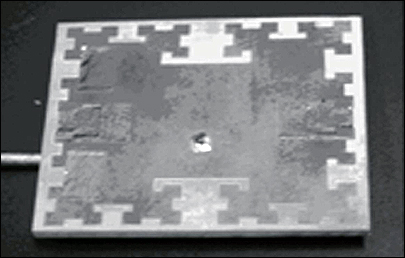In a recent study carried out by researchers at the Tampere University of Technology’s Rauma Research Unit, in Finland, a fractal UHF RFID handheld reader antenna performed better than traditional antenna designs. The research findings were published in a paper entitled “Read Range Performance Comparison of Compact Reader Antennas for a Handheld UHF RFID Reader,” in the April 2007 edition of the online magazine IEEE Applications & Practices.
The independent research compared the read range and orientation sensitivity of five miniature antennas, used in conjunction with a handheld UHF RFID reader. Created by the research team, the antennas consisted of four linearly polarized designs—a rectangular patch, an H-shaped patch, a fractal patch and a balanced dipole—as well as one circularly polarized design. The results showed that the fractal antenna had the longest read range (see the table on the following page).
The researchers suggest that the existence of small, lightweight UHF RFID interrogators with an extended battery life and long read range might increase interest in supply chain RFID applications that track inventory through manufacturing facilities, warehouses and retail stores. Fractal antennas could provide the handheld readers the required performance.
Conducted in 2006 and led by Leena Ukkonen, one of the paper’s coauthors and a professor at Tampere University of Technology, the study relied on tests done with the PL 3000, a UHF RFID handheld interrogator manufactured by Nordic ID, based in Salo, Finland.
The reader antennas were attached to the handheld reader externally, to take into account the effects of the electronic components inside the reader unit. To carry out the test, the researchers taped each antenna to the casing of the handheld reader, then measured the maximum reliable read range (MRRR) of four different commercial tags affixed to an empty corrugated cardboard box. MRRR was defined as the distance at which the tag could be continuously identified for at least one minute, with the tag and reader antenna aligned with one another.
All the tags were dipole-type and optimized for the European UHF RFID frequency band. According to the paper, the fractal patch antenna, which relies on a Koch fractal iteration with iteration factor of 0.25, produced the longest read range, at 1.25 millimeters. The circularly polarized patch, meanwhile, produced the shortest read range, at 0.13 meters.
| Maximum Reliable Read Range (meters) | ||||
|---|---|---|---|---|
|
Antenna Design
|
Tag 1
|
Tag 2
|
Tag 3
|
Tag 4
|
|
Rectangular Patch
|
0.26
|
0.29
|
0.26
|
1.02
|
|
H-Patch
|
0.20
|
0.21
|
0.25
|
0.62
|
|
Fractal Patch
|
0.30
|
0.37
|
0.67
|
1.25
|
|
Balanced Dipole
|
0.26
|
0.32
|
0.33
|
0.96
|
|
Circularly Polarized Patch
|
0.13
|
0.20
|
0.25
|
0.40
|
| Tag 1: short dipole antenna |
| Tag 2: long dipole antenna |
| Tag 3: bowtie-type antenna |
| Tag 4: reusable tag in plastic casing |
| Source: Tampere University of Technology, and IEEE Applications & Practice |
The PL 3000, measuring 230 mm in length, 90 mm height and 90 mm width, transmits data over the European UHF RFID band (869.525 MHz). The researchers chose the PL 3000 for its compact design, which would require a small internal RFID antenna. Tampere University’s engineers are now looking at methods to expand the frequency range, between 860 MHz and 950 MHz. This would provide businesses an opportunity to employ the reader in multiple regions around the world.
According to the paper’s two other coauthors—professors Lauri Sydanheimo and Markku Kivikoski, who also supervised the project at Tampere University of Technology—fractal modeling techniques offer a method for creating small, yet powerful, RFID antennas. The design is based on repeating geometrical shapes, either exact or modified. Thus, the technology uses one antenna but acts as if there are more, enabling it to achieve up to 50 percent longer read ranges, as compared with other antennas.
“Designing the antenna based on fractal modeling techniques,” Sydanheimo says, “lets the RFID reader operate on low power consumption.”
Two ways that fractal modeling techniques in UHF RFID systems can improve performance are in the areas of “impedance match” (specific requirements for the antenna characteristics) and “multiple current maxima” (one antenna that acts as many). Both techniques increase reader performance and range, explains Nathan Cohen, chief technology officer and founder of Fractal Antenna Systems, a Bedford, Mass., manufacturer of radio antennas.
Fractal Antenna Systems calls the university’s findings a “significant” step in efforts to grow market acceptance for fractal RFID antennas in commercial applications. The company holds two U.S. patents specific to RFID and fractal techniques. The most significant—patent No. 6985122, issued in January 2006—describes fractal modeling techniques for RFID antennas.
“We think fractal antennas will enable RFID to be used cheaply in ways people have been forecasting, but not executed,” Cohen says. “People are always skeptical of new technology, but this wasn’t research we paid for or knew about.”


